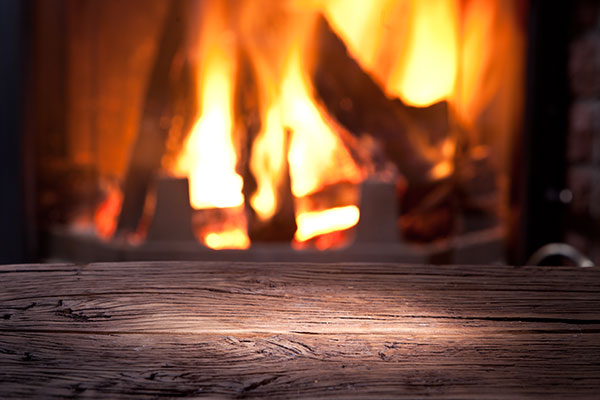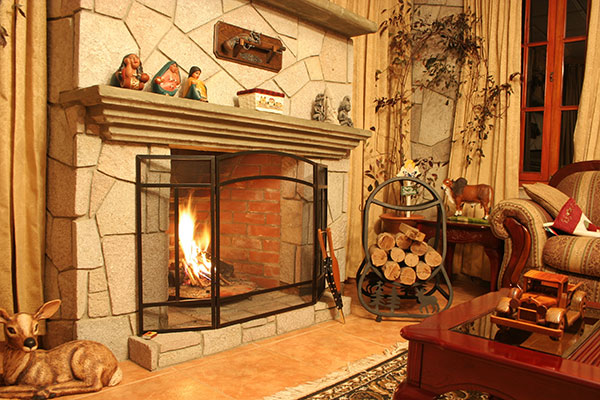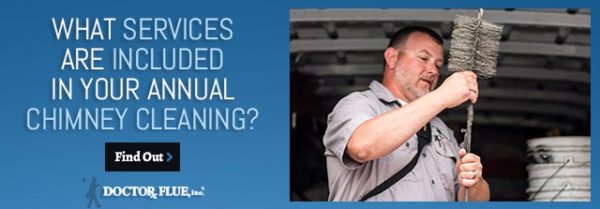
Sitting comfortably by the fireside on a chilly winter night is as classic an experience as they come. But if you don’t use your fireplace correctly or maintain your chimney, it also introduces a major risk to your health and home. The most common winter fire hazards involving your fireplace are easily avoidable as long as you know the precautions to take. Read on to learn about the best ways you can protect yourself from common fireplace hazards during the winter.
Only Burn Safe Combustibles
During the coldest nights of the year, you may find yourself running low on properly seasoned wood. It may be tempting to burn some of the fresh wood you were keeping for next year. In some cases, it may even seem like a good idea to burn trash or other items you wanted to get rid of. Don’t do it!
Burning wood that’s still green will produce a smoky fire without as much heat as seasoned wood. Not to mention all the creosote and soot it will leave in your chimney! You won’t get to enjoy the fire, and may have to deal with excessive smoke billowing back into your home. There’s even some wood, such as the type used for construction, that’s treated with chemicals and is unsuitable for burning.
Any creosote in your chimney contributes to the potential for a chimney fire. These dangerous fires will likely lead to long-term damage in your chimney, and the possibility of a more serious fire in your house as well.
Even worse, burning trash or other items not meant for fireplaces can introduce dangerous chemicals into the air. But that’s not all: light trash, like wrapping and paper can float due to the strong flow of air in a chimney. If it catches fire and floats into your home, it can start a fire.
Never Use the Fireplace Without a Screen
Because of the cold, you may be tempted to remove anything between you and the fire. Opening the screen won’t make any noticeable difference in heat produced by your fireplace, but it will put you and your family in danger.

Sparks from a fire are a constant risk. They can shoot off at random intervals, in random directions. It only takes one to ignite a house fire, and they’re often small enough that you may not notice it until it spreads. Keep the screen in place during any active fire. Without it, you’re putting yourself is harm’s way for no reason.
Clean Your Gutters & Roof Around Your Chimney
Conditions outside of your home can be a risk too! The purpose of your flue is to direct exhaust out of your home – but sometimes fire and sparks will go with it. Did you take care of all the leaves on top of your house this past fall? If not, they could easily be ignited by a wild spark flying out of your chimney!
In some cases, chimneys that have damaged chimney caps or no caps at all become filled with dried leaves, twigs or other debris. If you live in a well-wooded area like Ann Arbor, Michigan, you know how quickly leaves and branches can build up around your home! These are even more dangerous, as they’re almost guaranteed to catch fire from the intense heat and sparks from the fireplace. Even if they don’t, they can trap smoke in your flue, prevent proper airflow, and force deadly gasses into your home.
Remove any leaves from your roof, chimney cap and gutters. If you find other debris, keep it far away from the chimney.
Keep Fires Burning Reasonably
Frigid temperatures encourage homeowners to burn more intense fires – and they’re one of the biggest winter fire hazards involving your fireplace. Despite what you may think, a fireplace isn’t intended to handle all levels of open flame. If you stack too many combustibles, especially highly-flammable objects like starter logs, you can build a very big flame.
In addition to creating more smoke, they can also allow extreme temperatures to reach high into the chimney, where they may ignite deposits of creosote causing a chimney fire.
These raging fires will also increase the likelihood of wild sparks firing out from the firebox or chimney, potentially igniting nearby flammable objects.
Heating your home with a fireplace requires careful attention and precaution. Don’t use too much wood and avoid accelerants.
Don’t Forget About the Damper
Many homeowners don’t make enough use of their damper when trying to control a fire. Overloading your fireplace with wood to increase the temperature can lead to an unruly fire. If this happens, your damper will help you regain some control over the intensity of the flames.
Experiment with your damper to get a feel for how the increased or decreased oxygen impacts your fire. More oxygen will help feed the flames, while less oxygen will rein the fire in.
Never Leave a Fire Unattended
Even a waning fire is a potential risk when left unattended. No matter what you do, you should never walk away from a burning flame. If you’re ready to go to bed, or need to leave for the evening, ensure that the fire is completely stopped.
While you may think a fire is dying down on its own, a sudden rush of air can cause an unexpected resurgence. If you left the screen open, or have creosote in your chimney, a fire could start without you being there to stop it.
Schedule an Inspection
The most important step you can take to reducing fire hazards in your home is scheduling an inspection and cleaning of your chimney. Whether or not you plan to use your chimney, it’s important that it’s regularly inspected and cleaned.
For those that intend to make heavy use of their fireplace, it’s critical to hire a professional to inspect it annually.
Worried About Winter Fire Hazards in Your Chimney? Call Doctor Flue!
The CSIA-certified experts here at Doctor Flue offer chimney services and products in Michigan and Ohio and can inspect your chimney and identify any potential risks. Contact us today! We’ll get you set up right away so you can have peace of mind.
Call Us: 1-800-438-3583
Email Us: office@drflue.com
Office Hours: Mon-Fri: 8am-4pm
Connect with Doctor Flue on Social Media

